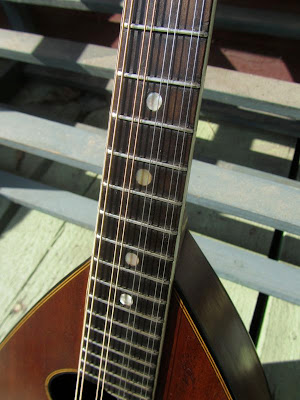c.1925 Harmony-made Mahogany Flatback Mandolin
This mandolin was made (more than likely) by Harmony in Chicago around 1925 or thereabouts. I had originally thought it was a Regal make (they made very, very similar models) but after looking a little more closely I'm darn sure it's a Harmony product, now. The body bracing wasn't quite right for Regal and also the heel shape and satin finish as well as the extra-thin wood is much more typical of Harmony builds from the time.
Essentially, this instrument is a very close likeness to a Martin flatback mandolin from the same period and has a similar sound as well: sweet, warm, decent volume and great sustain, but it doesn't have the cut a bluegrass player would be looking for. Rather, these are great instruments for old-timey and folk styles (as well as Celtic). They also do quite well for blues, too.
The mahogany top gives this instrument a good balanced range which works well for recording with.
The instrument is entirely made from solid mahogany, though the fretboard looks to be some sort of dyed hardwood (probably maple). The trim is rather fancy and the inset pickguard is faux-tortoise celluloid and in great shape. The whole mandolin, really, is in great shape -- save one repaired and cleated 6" long or so back crack on the rear.
Rosewood headstock veneer. Original bone nut.
So, right -- my work? Fixing that back crack, regluing a side seam that was loose, fret level/dress, cleaning, and setup. I also shimmed the bridge up just slightly and profiled the bone saddle for better action.
Pearl position dots. Bound fretboard.
Simple bug elegant looks.
The mahogany is awful gorgeous. This instrument came without a tailpiece cover but all the rest is original to it. The cover is same-period from my parts bin.
I totally enjoy the "hot cocoa" color of the instrument.
Check out the nice multi-ply binding on the rear, too!
Nice coverplate for the tuners. The tuners themselves work well and have been lubed.
Good heel join.
On the treble side "bottom edge" of the side, the wood is slightly warped but this is no issue and really not apparent unless you're looking for it. The binding just sliiiightly overhangs at this section.
Tailpiece.
















Comments